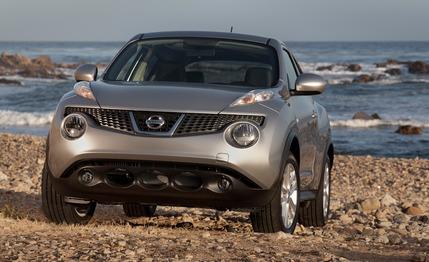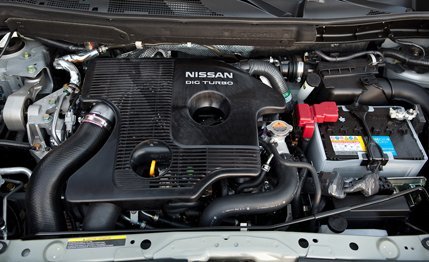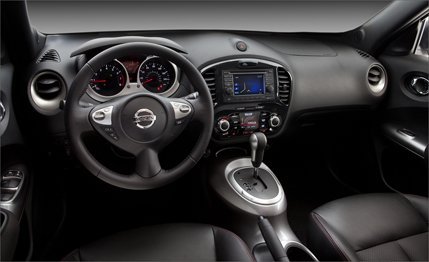 First Drive Review
First Drive Review
Besides being a type of box that exchanges money for music, “juke” is a football term, a fake-out in which a runner seems to go one direction when actually he’s headed in another. Juking is man’s work, and the little Nissan Juke crossover is likewise targeted toward men because, well, the similarly priced Nissan Rogue crossover just isn’t.
Based on Nissan’s global B platform, which is under the Nissan Versa and Cube and Renault Clio (remember, Nissan and Renault are one), the Juke was designed primarily by Nissan’s European studio and is a product mainly targeted at Europe. There, the B segment is red hot, and sales volumes can support all sorts of experimentation. The Juke is also wanted in China, where the small-car segment is growing faster than mold on month-old fruitcake. Nissan’s U.S. operations decided to take the Juke as an experiment to see if a new subsegment could be chiseled out of the already crowded crossover market.
The Other Compact Nissan Crossover
Yes, Nissan already has a four-cylinder cute ute called the Rogue that competes in a viciously contested segment with the Ford Escape, Honda CR-V, Toyota RAV4, Hyundai Tucson, and others. But that machine attracts mainly women, especially those in a family way, says Nissan’s head of U.S. product planning, Larry Dominique. In contrast, the Juke, available in S, SV, and SL trim levels, is after “aggressive attention seekers”: read "men who are still pretty much boys (and may always be so) and who star in YouTube videos opening with the line, “Watch this!”

The Juke, which will start within a few dollars of $20,000, or just over a grand less than the Rogue, is somewhat smaller and pitched at buyers of the Mini Cooper S, Mazda 3, and Scion tC. The wheelbase is 6.3 inches shorter than the Rogue’s, and the overall length is 20.5 inches shorter, with a substantially smaller cargo area. The downsizing is most noticeable in the rear seat, which is fairly snug. But there’s generally only one circumstance in which guys worry about back-seat space, and that one’s rare anymore.
Party in the Front
Guys like interesting hardware specs, and the Juke has them. There’s only one engine headed to the States: a feisty (single scroll) turbocharged and direct-injected 1.6-liter four-cylinder. Transmission choices are a continuously variable automatic or a six-speed manual, the latter available only in front-drive vehicles.
It’s a small engine for a car whose lightest version starts at about 3000 pounds, but output will be “over 180 hp and 170 lb-ft of torque,” says Dominique. The company won’t reveal the official power numbers until closer to the car’s on-sale date in October. One thing we can reveal is that the Juke doesn’t feel slow. In fact, the bells-and-whistles version we drove with a CVT and all-wheel drive jukes through traffic with a punchy throttle and welcome lack of turbo lag. The driver can select from normal, sport, and econ modes with the optional I-CON or “integrated control” mode selector, which tunes the throttle and transmission response and steering weight to the setting.

What’s in a Name?
The Juke can also handle a corner. Although the seating position and the center of gravity are ratcheted up, the Juke feels stable and eager to change direction. It shares a floorpan with the Versa but not its rear suspension. The Juke’s rear is supported by a tangle of steel multilinks. The suspension works in concert with a sort of performance-oriented all-wheel-drive system that uses two separate electronically controlled wet clutch packs on the rear axle. The clutches distribute engine torque left or right for sharper steering response when a brace of sensors monitoring steering angle, lateral-g load, and yaw rate report that it’s needed. All-wheel drive will probably cost $1200 to $1600 extra, with a fuel-economy penalty of 1 to 2 mpg compared with the 30-mpg expected city/highway combined number for the front-driver.
On dry roads, the clutch packs on either side of the aluminum-case rear differential are clamped tight for a 50/50 torque distribution (a dash switch allows you to disable the system for two-wheel-drive running). In corners or when starting from a dead stop, the system clamps and unclamps the two sides as needed, shifting more engine torque to the outside wheels to help push the nose in the desired direction. Just as in upscale SUVs with similar systems, the net effects are a livelier helm and a distinct lack of understeer. Nobody who loves a Mini’s hyper-reactive steering will think it anything special, but a Mazda 3 owner might.
Like a Mini, the Juke is highly stylized. The interior theme is “robobiotic” says Nissan, meaning a fusion of organic and mechanical. Maybe, but the best aspects are the motorcycle cues, such as the center console that looks like a crotch rocket’s fuel tank. The best thing the Juke has going for it is its unique package. A small pseudo-crossover with extroverted styling, satisfying power, and competent handling at a relatively low price is territory that hasn’t been explored yet. We see a compelling combination.